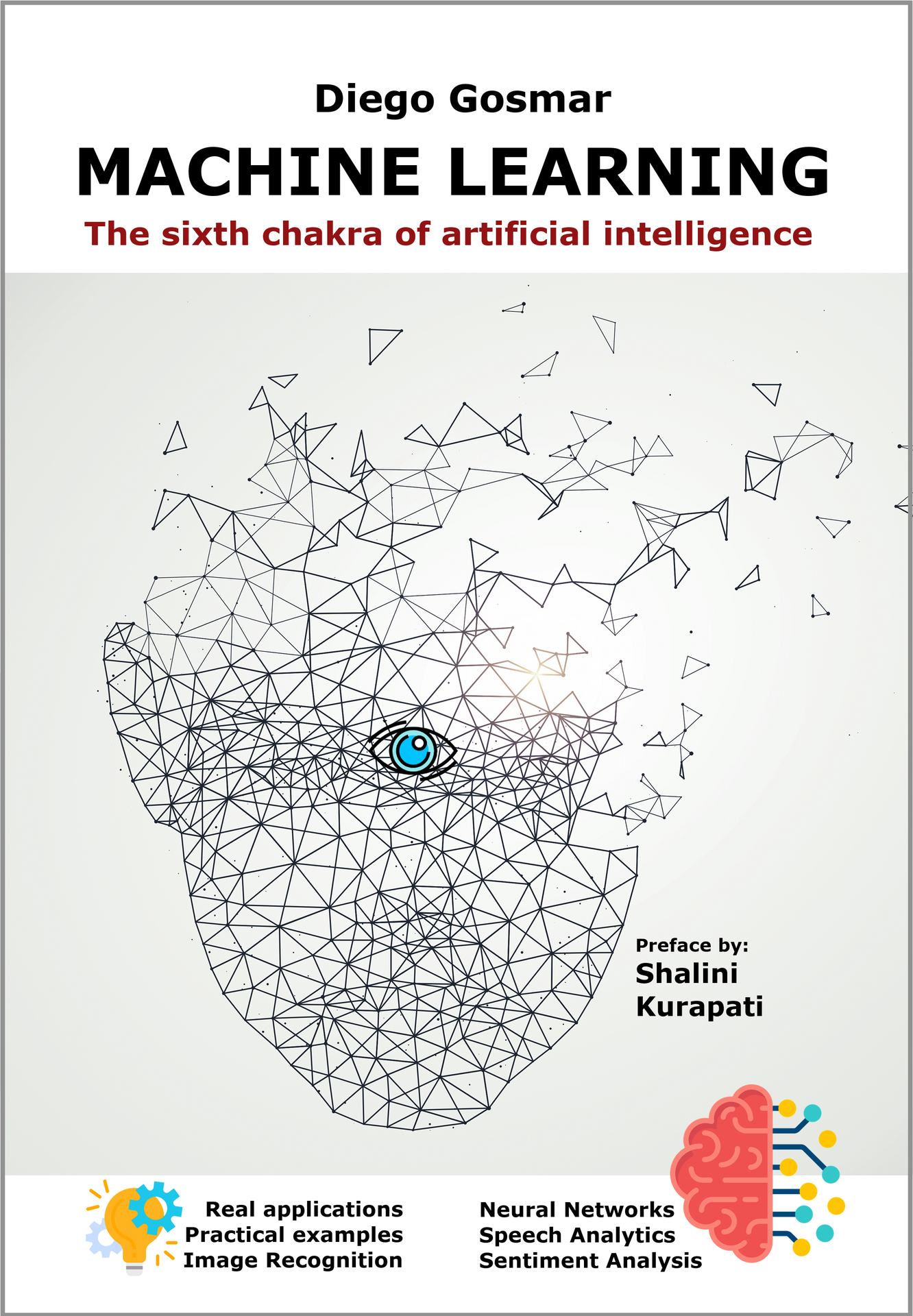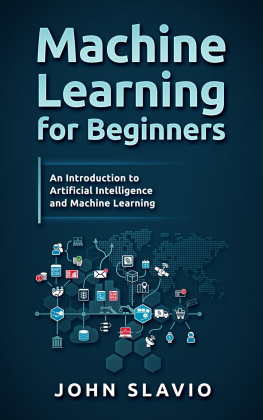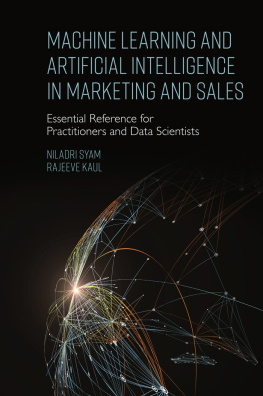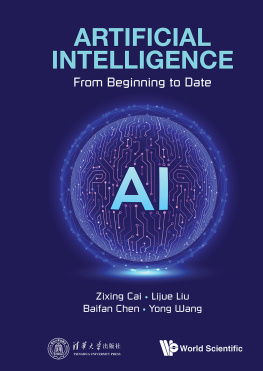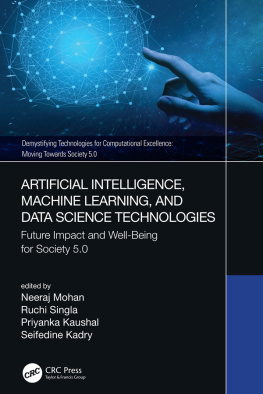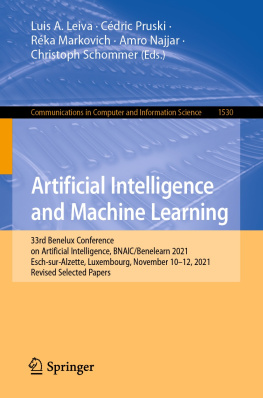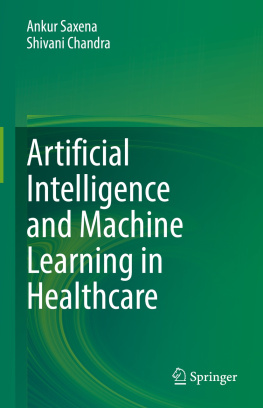Machine Learning
The sixth chakra of artificial intelligence
Diego Gosmar
Preface by Shalini Kurapati
Copyright 2020 Diego Gosmar
Layout:
Diego Gosmar
Proofreaders:
Daisy De Gioannini
Dario Gosmar
Cover:
Liu Zishan
Preface:
Shalini Kurapati
All rights are reserved by law and by international conventions.
No part of this book can be reproduced with electronic, mechanical or other systems, without the written authorization of the author.
Names and trademarks mentioned in the text are usually deposited or registered by the respective manufacturers.
And if I have a prophet's power and knowledge of all the secret things; and if I have all faith, by which mountains may be moved from their place, but have not love, I am nothing.
I Corinthians 13:2
Dedicated to Daisy, Delia e Dario
Foreword
We live in the age of AI.
Artificial Intelligence (AI) is ubiquitous in todays business and technology landscape. From industrial automation to smart homes, from online advertising to predictive analytics, from self-driving cars and medical diagnostics, AI is everywhere.
Artificial intelligence is going to enhance every aspect of our business and society so much that it is expected to add at least 15 trillion dollars to the world economy by 2030. The Covid emergency is expected to further accelerate the adoption of AI and it will play a central role both in the business processes as well as business models of companies.
Nowadays AI and Machine Learning are being used almost as synonyms. AI is an umbrella term for a number of techniques that can process data and give predictions and decisions. Whereas Machine Learning is one of the most powerful AI techniques that can efficiently handle and analyse large amounts of data to give accurate predictions, automated decisions and give unprecedented business advantages.
Machine Learning is particularly powerful and quite spectacular because, given enough data, it can predict, analyse or automate decisions without explicitly being programmed to do so.
Given the increasingly exponential amount of data that companies have access to, Machine Learning becomes the key to harness the riches of the data gold mines at their disposal.
This is exactly what Diego presents and creates a special focus in the book, starting from the title, on the power of Machine Learning among the various AI methods.
He outlines the essential principles and methods of ML in a lucid manner that makes the book a suitable reading even for non-computer engineers/data scientists. Managers and innovation departments of companies can benefit by reading this book to get a better understanding of how ML can streamline their operations and augment productivity, with an eye on the future.
Diego has a rich entrepreneurial experience in applying technology for successful business applications in the field of customer care management.
I recommend his book for anyone with an innovation mindset who is curious to learn about Machine Learning and some of its practical business applications.
Shalini Kurapati, PhD
Co-founder & CEO
ClearBox AI
Contents
Introduction
I n the 90s I was attending the university lectures: I remember one of the many signal processing theory courses in which the Professor illustrated the Convolution operations between two mathematical functions.
Putting it simple, it is a matter of "multiplying" two waveforms between them where the former remains the same, while the latter is overturned and translated.
What could such an operation do and why use it?
Several years have passed since that theoretical course, but for various reasons I had never had the opportunity to apply what I learned up to some time ago, more precisely when I approached the world of Machine Learning and I came across Deep Learning algorithms and Convolutional Neural Networks .
While I am still working on this book, we arrive in March 2020: we are in the midst of the global crisis due to CODIV-19, an event so unexpected and underestimated, but with the power to change the balance of the entire planet in few days.
We are not just talking about a health crisis bringing entire nations to their knees, but a social crisis leading to a radical change in the way we live relationships, with significant impacts on our future.
For some time now I have been working to understand what the real benefits can be by using Machine Learning for data processing applications. I am trying to do it according to critical and objective methods, by finding, trying and retrying also through some significant experiments.
While confined at home - to follow government guidelines to reduce the spread of the virus - this research [5] comes to my mind, as a further support to demonstrate that data science applications already are and will become even more strategic in the future:
A deep learning algorithm using CT images to screen for Corona Virus Disease (COVID-19) : https://t.co/vJzZLIrPfH
This is about an abstract published by a series of experts from various research centers in Tianjin in China.
One of the problems generated by Covid19 consists in the need to identify the virus positive subjects as quick as possible. Pathogenic laboratory tests have been the diagnostic standard so far, however they are time consuming and also produce numerous false negatives.
Starting from COVID-19 radiographic elements, the experts sought to develop an automatic learning algorithm by using Deep learning and Convolutional Neural Networks, capable of recognizing the virus and therefore providing a clinical diagnosis before the pathogenic test. As a result, they are able to save essential time for disease detection.
During the experiment, 1119 radiograph images of confirmed COVID-19 cases by pathogens were collected, together with those previously diagnosed with typical viral pneumonia.
The internal validation reached a total accuracy of 89.5%.
Furthermore, out of 54 COVID-19 images, for which the first two traditional pathogenic tests on nucleic acid provided false negative results - therefore erroneously unable to identify the virus - 46 were identified positive to the COVID-19 by the Machine Learning algorithm, thus providing 85.2% accuracy.
Such results demonstrate how machine learning tools can be an effective methodology, in order to extract radiological features to carry out timely and accurate COVID-19 diagnosis.
The Chinese expert study focuses on the application of Convolutional neural network algorithms .
Extract from the Tianjin Scientists abstract:
Artificial Intelligence involving medical imaging deep learning systems has been developed in image feature extraction, including shape and spatial relation features. Specifically, Convolutional Neural Network ( CNN ) has been proven in feature extraction and learning.
Furthermore:
CNN was used to enhance low-light images from high-speed video endoscopy with the limited training data being just 55 videos. Also, CNN has been applied to identify the nature of pulmonary nodules via CT images, the diagnosis of pediatric pneumonia via chest Xchest X-ray images, automated precising labeling of polyps during colonoscopic videos, cystoscopy image recognition extraction from videos....
So not just COVID-19.
In short, there is enough to understand we cannot consider Machine Learning and Artificial Intelligence just as something abstract - or even as in science fiction where cyborgs perform human work - but we can talk about techniques and algorithms already available today, thus to perform applications quite useful to the entire world community.

